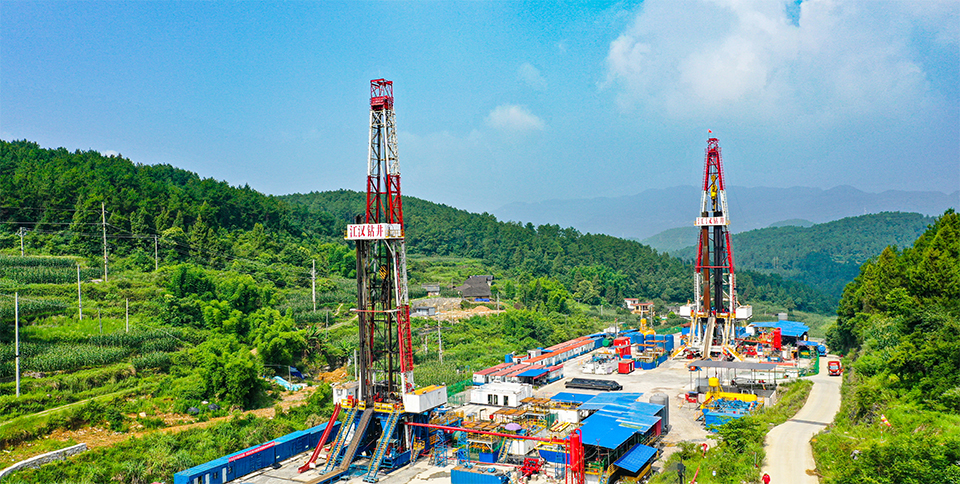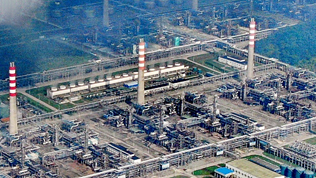Breakthrough in the application of the “Matrix” rotating steering system. 9 core technologies and 4 innovation items have been developed, featuring high reliability, wide adaptation range, complementary logging and steering, accurate trajectory control, independent control and open compatibility, etc. The overall system has reached the international advanced level, among which the measurement accuracy of the steering bit and azimuth resistivity reached the international leading level. The system has been applied to 83 wells in Sichuan and Chongqing shale gas, Shengli Jiyang shale oil, Bohai Bay onshore recovery of the offshore oil, and eastern complex structure wells, with a total cycle time of 8687.48 hours, a footage of 64,600 meters, a maximum drilling build-up rate of 11.5°/30 meters and a reservoir penetration rate of 96%. In the Shengli Fanye 102-HF well, the Company achieved the first “one-run drilling” for a shale oil well drilling casing and tubing. In the Jiaoye 70-S2HF well, new records for domestic rotary steering system were set, such as one-run drilling footage of 1,980 meters and a continuous trouble-free working time of 276 hours.
Significant improvements in the speed, efficiency, and quality of geophysical prospecting projects. In China, more than 2,160,000 shots were completed throughout the year, exceeding 2 million for the first time. The average daily efficiency of the Sinopec-market 2D and 3D seismic exploration projects was increased by 220%, and the rate of first-rate acquisition data was increased by 3.2 percentage points compared with the contract requirements. 3 projects in Taoerhe, North Taji and South Shizhu won the Group’s Outstanding Project Awards. All completed 3D seismic projects were awarded as Outstanding Projects by the Party A. The advanced geological prospecting technology further supported high-quality exploration and development.
Increasingly mature deep well drilling supporting technologies. Through innovations and iterations, we formed a series of speed-up technologies for ultra-deep wells, including the pre-bent drilling tool combination anti-deviation technology in the Shunbei area, vertical drilling + screw drilling technology, “aggressively shaped tooth PDC bit + high-torque screw drilling tool” high-efficiency rock-breaking technology, and series of speed-up technologies, such as fine pressure control drilling technology in the southwest area, safe liner tubing technology for acid gas ultra-deep horizontal wells and anti-corrosion and anti-channeling cementing technology for ultra-deep acid gas reservoir. During the year, 172 ultra-deep wells were completed with an average well depth of 6,890.7 metres, an average mechanical drilling speed of 8.93 metres per hour and an average drilling cycle of 111.19 days, achieving good results in terms of speed and efficiency improvement. The Rentan 1 well set new records for the largest number of layers traversed by a 165.1mm diameter borehole and the longest open hole section in the North Block in Sichuan Basin; the Yuanshen 1 well set seven high records for Sinopec in the Sichuan Basin, including the deepest completed vertical depth and the deepest depth of casing with 476.25mm diameter.
Breakthroughs in shale oil and gas engineering supporting technologies. We achieved technology breakthroughs, field application and iterative upgrading for shale gas ultra-long horizontal section drilling, cementing technology, drilling stem bi-directional twisting system control technology, horizontal infill well bypass technology, foam cement leak plugging process and shale oil coring drilling with long core barrel, high temperature resistant rotary steering tool selection, synthetic-based drilling fluid performance optimization and other key areas. Last year, we completed the drilling of 269 shale gas wells with footage of 1.4264 million meters, an average well depth of 5,222.05 meters, an average mechanical drilling speed of 9.33 meters per hour, and a drilling cycle of 73.27 days. 22 wells were completed in the Jiyang Shale Oil Project, with an average well depth of 5,754 meters, an average mechanical drilling speed of 9.87 meters per hour, and an average drilling cycle of 69 days, big increase in both quality and efficiency. Among them, the Jiaoye 18-S12HF well set a number of construction records, including the longest horizontal section (4,286m) and the longest horizontal section “one-run drilling” (4,225m) in China. The Niuye 1-3HF well set two records in Shengli Jiyang shale oilfield, including the deepest depth (6,200m) and the longest horizontal section (2,425.09m). A number of wells, including Fanye 105HF, Fengye 1-4HF, Niuye 1-3-501HF and Fanye 102-1HF, achieved one-run drilling for drilling, casing and tubing. Niuye 1-3-501HF set a new record for the shortest drilling and completion period (29.5 days) for a horizontal shale oil well in Shengli Jiyang.
Great improvement in downhole special operations and reservoir technology. The shale (oil) gas fracturing speed and efficiency improvement technology was iterated to V3.0 generation. The technology series of oil and gas tests for wells with high pressure, sulfur and dangerous potentials in key work areas such as Yuanba and Shunbei were continuously improved. The efficiency of fracturing in key areas of Northeast, Northwest, North China and Sichuan increased by 15.6%. The Fuling shale gas field’s Jiaoye 12 platform expansion achieved three-dimensional development and set five records, including the largest scale of shale gas fracturing in China. The Shengli shale oil Fanye 1 well group set three records, including the most fracturing work volume in a single day in the eastern part of China. The Xinye 1 well, a key shale gas well in the southern Sichuan, achieved test gas production of 530,000 cubic metres per day after fracturing. Accumulative 20 high yielding oil wells with a daily production of 1,000 tonnes was tested successfully in Shunbei. The oil reservoir business built 520,000 tonnes of new crude oil production capacity and 700 million cubic metres of new natural gas production capacity in the year, promoting development of both conventional and unconventional oil and gas.
New progresses in drilling fluid technology. The high temperature resistant poly-sulphonate low friction drilling fluid system was successfully applied to the Shunbei 801 X well and the Shunbei 4-11H well, with the bottom temperature reaching 191℃, effectively ensuring the smooth completion of the 9,000m ultra-deep well. The anti-high temperature environmentally-friendly drilling fluid filter loss reduction agent has been applied to more than 200 wells, providing strong technology support for key wells such as Yuanshen 1, Xiantan 1 and Yuanba 701. The oil-based drilling fluids in West Sichuan solved the problems of well wall collapse, control of the rheology of high-density drilling fluids and sliding drilling pressure in the sand-mud interbed of the Shaximiao Formation in the Zhongjiang work area in West Sichuan. The application of oilbased drilling fluid technology in the TKC3-2X well in the Tahe work area saved 20.37 days in drilling cycle, with a 36.38% cycle saving rate, setting a record for the shortest drilling cycle in a horizontal well in carboniferous clastic rock. The synthetic-based drilling fluid was applied to 14 wells in Shengli Shale Oilfield, resisting temperature of 200℃, reducing 82% of mud cake permeability and over 40% of solid waste.
Accelerated breakthroughs and industrialisation of logging and mud logging technologies. In MWD, the Company developed a series of three types of instruments, among which azimuth gamma and azimuth electromagnetic resistivity were applied in scale, and field testing of neutron density and gamma energy spectrum was accelerated. The application of azimuth resistivity logging in the Zaizhuang 139-Ping 25 well enabled precise control of the trajectory of the boundary detection and 100% reservoir penetration rate, successfully breaking through the “bottleneck” in the application of shallow and loose formations. In open hole logging, the temperature and pressure resistance and stability of imaging logging continued to improve. The 200°C/172 MPa cable push-type and lantern-type high-temperature electrical imaging logging technologies became mature, which were applied to 9 wells in northwest and southwest China. 200°C/206 MPa direct push storage series of logging instruments were applied in wells for 309 times. Among them, 61 times were in ultra-deep wells above 8,000m. The expected results were achieved in all field applications. In terms of logging technology, the temperature and pressure index of through bit storage logging were improved to 175°C/140 MPa, realizing “ logging integration”. This technology was applied to 122 wells in total, speeding up by more than 40% in a single well, becoming the core tool for the logging of Shengli Jiyang shale oilfield. The tractor series continued to be completed, forming the 50 mm, 70 mm and 80 mm series, completing 409 times of well traction, and completing the first tractor throughtube logging in the Xin1-5H well. In terms of logging interpretation, a series of five types of complex reservoir logging and evaluation technologies were developed. Software module version 1.0 was developed based on the LogPlus platform. In terms of mud logging technology and equipment, high-end mud logging equipment was finalised and initially applied. 25 directional well, mud logging, steering integrated technology specifications and standards were written and completed. Key projects were accelerated, such as a Coriolis flow meter-based drilling fluid flow measurement device, a new type of rock debris weighing device manufacturing and a supporting borehole stability monitoring system, and development and testing for a prototype carbon isotope analyser. Milestone results were achieved for field tests and applications.
Innovation of surface engineering technologies and progresses in five major aspects. Important progress was made in science research and development. Three major national projects were undertaken. Two technologies were selected in the Catalogue of Advanced and Applicable Technologies for the Conservation and Comprehensive Utilization of Mineral Resources of the Ministry of Natural Resources of China. 2 CCUS technologies were shortlisted in the National Key Research and Development Program, namely “Biomass CCS Potential and Demonstration Feasibility” and “Development of key technology and equipment for carbon capture and mass transfer enhancement of flue gas for one million tonnes per year”. The first domestic mega-tonne coal-fired power plant flue gas carbon dioxide capture process package was developed and implemented in the pipeline of Qilu Petrochemical-Shengli Oilfield mega-tonne CCUS demonstration project. The first upstream natural gas ethane recovery process package was completed to fill Sinopec’s technology gap in the related field. Welding technologies such as TIG external root welding were innovated, which can achieve automatic welding on 30° steep slopes in mountainous areas, increasing welding efficiency by 2-3 times and achieving a 98.36% passing rate for welding. The application of BIM technology was vigorously promoted and applied on a large scale in projects such as the building of 1 billion cubic metres of natural gas production capacity in the No. 4 zone of Shunbei No. 2 area, the South Shandong Trunk Line and the construction of LNG tanks in Longkou, with an increase of 3%-11% in the overall efficiency of man and machine. Surface engineering technology development was sped up comprehensively from 5 major aspects. 13 upstream surface engineering management system documents were completed. The development results of long-distance pipelines, oil fields and gas fields containing sulphur were finalized. Progress was made in the modular construction consisting of “modular design, factory skidding and on-site assembly”, smart construction sites and digital twin construction. Such construction model was successfully put into practice in projects such as the Dongying Crude Oil Depot relocation project, which increased overall construction efficiency by 30%, shortened the construction period by 7 months, and optimized the number of on-site operators from 182 to 20, thus fully achieving the “five” conservation goals.
Faster IT development. The SICP applications were built around the major goal of “project management” to achieve the dynamic integration of all business management, promote information sharing and improve work efficiency. Based on twin technology, the first domestic digital twin system for real-time data-driven drilling and fracturing process conditions was implemented, providing a more realistic field perception for the decision making by the command centre. The “Well Site Integrated Decision Command Centre” system for the frontline, based on the SICP data centre’s three-layer data model of “well - borehole - operation”, achieved the goal of assisting personnel from different expertise and positions to work together on a unified application platform. The construction of professional application systems such as well site seismic visualisation, equipment IoT and engineering anomaly warning provided a full range of application tools for multiple technical positions such as drilling, mud logging, directional and steering.
Accelerated iteration of core petroleum engineering equipment. Fixed assets investment was 4.6 billion yuan throughout the year. 41 drilling rigs were upgraded and revamped, including 5 newly purchased 8000m rigs, 8 newly purchased 7000m rigs and 63 sets of upgraded core equipment. The share of electric drilling rigs was increased to 56%. The share of grid electric drilling rigs was increased to 47%. The number of modern and enhanced drilling rigs reached 150, an increase of 12%, 5% and 15% respectively. The equipment structure was further optimized, providing better support.
Innovation of oil and gas equipment technology. 7,000m automated drilling rig was applied to the Yellow River drilling team 70183; the second generation of 5000 all-electric fracturing equipment was improved and upgraded, setting a record high fracturing efficiency of 7 sections/day in Shengli Jiyang shale oil and achieving excellent performance of 9 sections/day in the first shale oil demonstration well in northern Jiangsu. The National Energy Administration (NEA) “strengthen weaknesses” projects progressed steadily. The first 200,000 cubic metre high sulphur gas compressor in China was successfully applied in the Puguang gas field. The world’s first fully electric-driven automatic workover rig, 2500-type “one-button cementing” equipment, the first domestic electric-driven automatic coil tubing operation equipment and remote-controlled pressure operation equipment were successfully developed. 52 MPa gas storage compressor set the highest injection pressure record in China, and CO2 re-injection compressor was successfully developed. New products such as highly reliable and long-life hybrid drill bits, RSS matched diamond bits and high-torque screw drilling tools set the industry benchmark. The drilling bit and tool research and selection platform was put into operation, with 546 new high indexes. The first set of underwater wellhead for production wells in China was successfully applied. The development of digital intelligence technologies such as automated control of fracturing equipment and manifold, SOFElink Internet of Things were accelerated.





 Address
Address Post code
Post code Tel
Tel 京公网安备11010502035639
京公网安备11010502035639 



